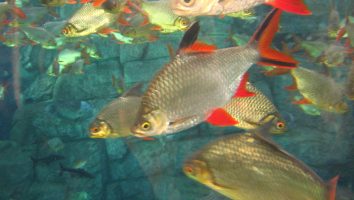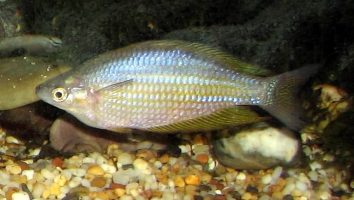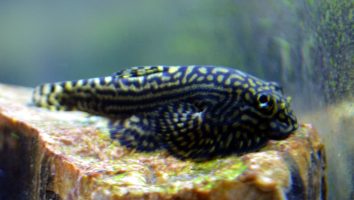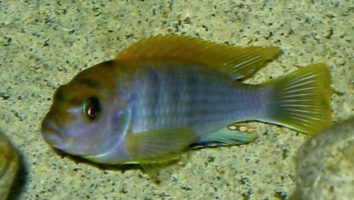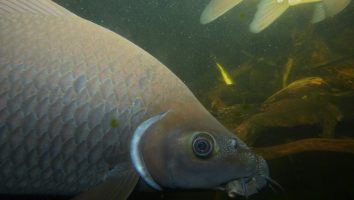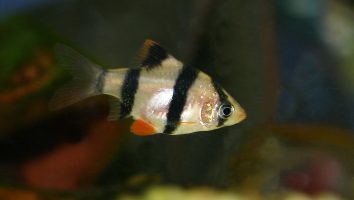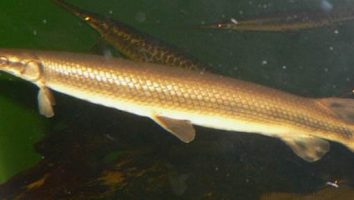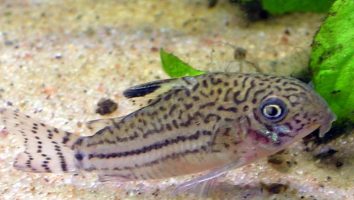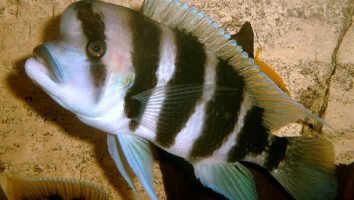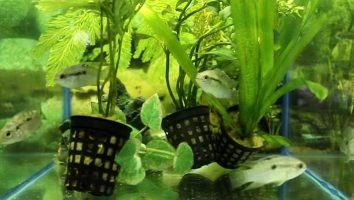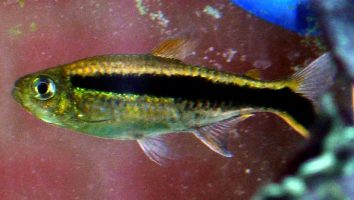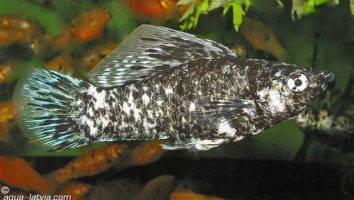The Fiveband Barb is a peaceful and hardy freshwater fish that’s perfect for beginner aquarium hobbyists.
This species is very easy to care for and can live in a wide range of water conditions. They’re also very active fish that love to swim, so they’re a great addition to any community tank.
In this care guide, we’ll teach you everything you need to know about keeping Fiveband Barbs happy and healthy. You’ll learn about their diet, tank mates, lifespan, and more!
Table of contents
Species overview
The fiveband barb (Puntius pentazona) is a tropical fish that’s found throughout Southeast Asia in countries like Cambodia, Laos, Thailand, and Vietnam.
They prefer habitats with a lot of plants and hiding places. This could be in the form of dense vegetation or a lot of driftwood.
The fiveband barb is a peaceful fish that does well in community tanks. They can be kept with a wide variety of other fish, as long as they’re not too small (as the fiveband barb may eat them).
This fish gets its name from the five black vertical stripes that run down its body. These stripes are quite prominent and are one of the main features that make this fish so popular.
Appearance
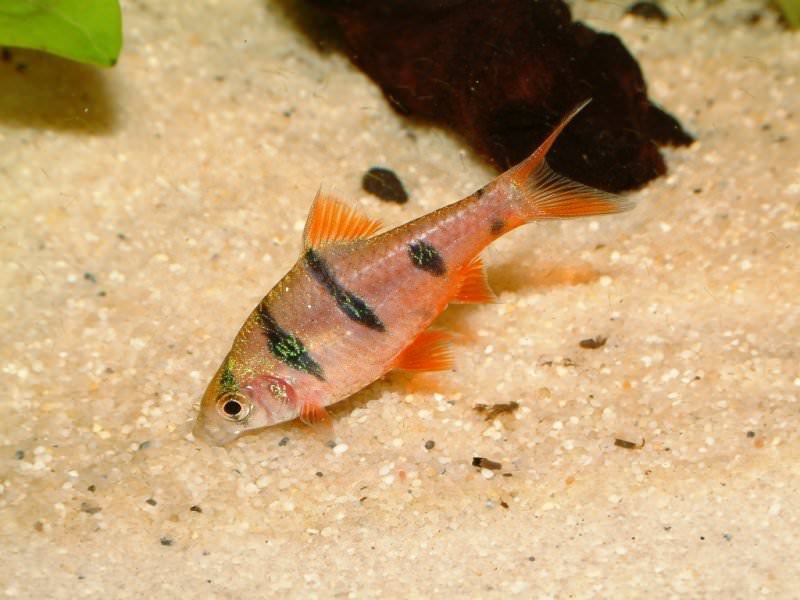
The Fiveband Barb is a very colorful fish that is sure to stand out in any aquarium. As the name suggests, this fish has five distinct bands running vertically down their body.
The first and most notable band is a bright orange that starts at the gill plate and extends back to just before the dorsal fin.
This is followed by a thin black band. After the black band, there is another orange band that is thinner than the first. This is followed by a thinner black band and then another orange band.
The last band is a thick black band that goes from the base of the tail to the anal fin. This black band is what gives this fish its name.
The dorsal fin, anal fin, and caudal fin are all black with a hint of orange near the base. The ventral fins are also black.
The body of the Fiveband Barb is long, thin, and torpedo-shaped. This helps them to be very speedy swimmers.
Lifespan
The average lifespan of a fiveband barb is around 5 years. However, there have been some reports of these fish living up to 10 years in captivity.
The biggest factor impacting the lifespan of a fiveband barb is the quality of the water they’re kept in.
These fish are very sensitive to changes in water quality and will not do well in an environment that is not well-maintained. If you can provide them with pristine conditions, they should be able to reach that 5-10 year mark.
Size
The average size of a Fiveband Barb is between 4 and 6 inches, with males being slightly larger than females. These fish can grow up to 8 inches in length, but this is relatively rare.
Tank
Tank Size
The recommended tank size for fiveband barbs is 30 gallons. This is for a school of 5 or more fish. If you’re looking to keep a single fish, we recommend a tank size of at least 50 gallons.
As with most fish, the more space you can provide the better. These fish are very active and need a lot of room to swim.
Water Parameters
The Fiveband Barb is a tropical fish that needs warm water to thrive. They are also a schooling fish, so you will need to provide them with plenty of space. A 20 gallon tank is the minimum size for a school of Fiveband Barbs.
The water parameters for the Fiveband Barb are as follows:
- Water temperature: 75-82 degrees Fahrenheit
- pH levels: 6.5-7.5
- Water hardness: 5-19 dGH
- Alkalinity Levels: 3-10 dKH
What To Put In Their Tank
When it comes to setting up the inside of an aquarium for Fiveband Barbs you can be as creative as you want. There aren’t any specific things that this species NEEDS to have, which gives you plenty of options.
We recommend some of the standard decorations that you find in a lot of freshwater tanks. There are a ton of great plants you can include (like hornwort or water wisteria). You can even throw in some floating aquarium plants too!
Rocks, driftwood, and caves are all suitable as well. It’s important to avoid going overboard with this since these fish like some room to swim.
Also, if you’re keeping your Fiveband Barbs in a smaller tank then it’s going to be difficult to include a lot of this stuff anyway.
A classic gravel substrate is always a good choice, but you can do with something soft and sandy if needed too (use other species you keep as a guide with this).
Common Diseases
The fiveband barb is a pretty hardy fish, but that doesn’t mean they don’t get sick from time to time.
The most common disease that affects these fish is ich. This is a pretty common freshwater parasite that can affect any fish, no matter how big or small.
The most obvious symptom of ich is the presence of white spots on the body, fins, and gills of your fish. If you notice this, it’s important to take action immediately.
There are a few other diseases that can affect the fiveband barb, but they’re not nearly as common. Some other potential illnesses include:
-Hole in the head disease
-Fungal infections
-Bacterial infections
-Viral infections
If you notice any of these symptoms, the best course of action is to consult a vet as soon as possible. They will be able to diagnose the problem and provide you with the necessary treatment.
Behavior & Temperament
The fiveband barb is a schooling fish, so it does best when it’s kept in groups. In the wild, these fish school together for protection. The same is true in aquariums.
When they’re not in a school, they can be a bit skittish and may hide a lot. If you want your fiveband barb to be out and about, it’s best to keep at least six of them together.
These fish are peaceful for the most part, but they can be a little nippy. They may nip at the fins of other fish. They’re also known to eat smaller fish, so it’s best to avoid keeping them with any fish that could fit in their mouth.
The fiveband barb is an active swimmer and will move around a lot. They’re constantly on the lookout for food, so you may see them sifting through the substrate or swimming in and out of plants.
Tank Mates
The fiveband barb is a schooling fish, so it’s important to keep them in groups of at least six. This will help reduce aggression and make them feel more comfortable in their environment.
When it comes to compatible tank mates, look for other peaceful fish that occupy different areas of the tank. The fiveband barb is an active swimmer and likes to be in the middle to upper levels of the water column.
Here are some good fiveband barb tank mates to consider:
- Neon Tetra
- Cardinal Tetra
- Congo Tetra
- Black Neon Tetra
- Glowlight Tetra
- Rummy Nose Tetra
- Ghost Shrimp
- Cherry Shrimp
Breeding
The Fiveband Barb is a beautiful fish that is not too difficult to breed in captivity. They are mouth brooders, which means the female will carry the eggs and fry in her mouth until they are ready to be released.
To start the breeding process, you will need to set up a separate tank for the fish. The tank should be at least 30 gallons and should have a lot of hiding places. Use plants, driftwood, and rocks to create a natural environment.
The water temperature should be between 75 and 82 degrees Fahrenheit. The pH should be between 6.8 and 7.2. Keep the water hardness on the lower side.
When the tank is set up, add two females for every male. The males will be the larger of the two sexes.
The fish will spawn in the morning. The female will lay around 200 eggs, which the male will then fertilize. The eggs will sink to the bottom of the tank and attach themselves to plants or rocks.
The female will then pick up the eggs in her mouth and carry them around until they hatch. This process takes around two weeks.
Once the fry have hatched, the female will spit them out into the tank. At this point, you can start feeding them baby brine shrimp or other small live foods.
Conclusion
The Fiveband Barb is a great fish for anyone looking for a little bit of excitement in their aquarium.
While they are relatively easy to care for, they are also very active and can add a lot of movement to your tank.
They are also quite hardy, so they can tolerate a wide range of water conditions.
Overall, we think the Fiveband Barb is a great choice for anyone looking for a fun and active fish for their aquarium.

